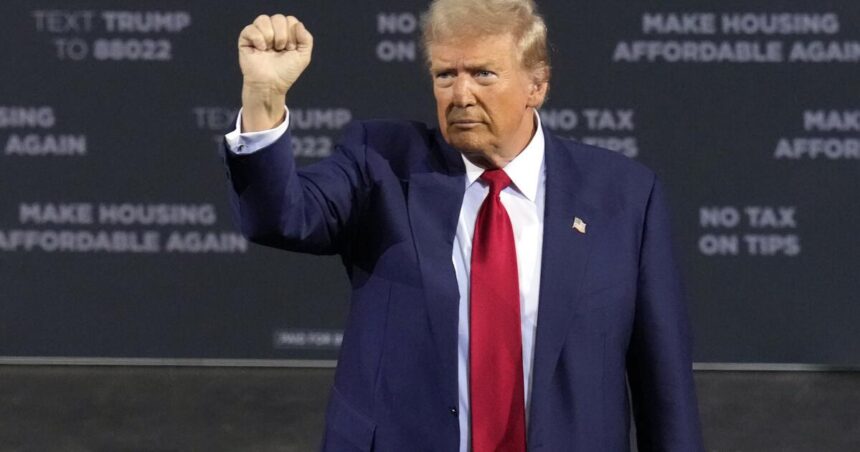When Donald Trump was last president, he touted many of the benefits of the 2017 law, but multiple bipartisan reviews found that it primarily benefited the wealthy, significantly increased the federal deficit and failed to deliver the promised economic benefits to the middle class.
Perhaps recognizing that the previous tax cuts lacked populist appeal, the former president spent the summer crafting new tax cuts, promising to eliminate gratuities, Social Security benefits and federal taxes.
President Trump used a rally in Tucson on Thursday to announce his latest proposal to end the tax on overtime pay.
“These people who work overtime are some of the hardest working people in our country,” the Republican presidential candidate said, “and for too long, no one in Washington has paid any attention to them.”
He said the proposals meant “police officers, nurses, factory workers, construction workers, truck drivers and machine operators” would finally “get a break.”
Tax and policy analysts across the ideological spectrum were quick to denounce the Trump plan for widening an already massive federal budget deficit. It was not immediately clear how much the repeal of the three taxes would cost the U.S. Treasury, but one group said the Social Security tax ban alone would cost the government $1.6 trillion in lost payments over 10 years.
Some critics said the proposal panders to working-class voters whose support could tip the balance in some states. Providing breaks for people who earn tips and overtime feels like a “scam,” they added. This is coming from a man whose Department of Labor failed to protect workers’ tips and instituted policies that made millions of employees ineligible for overtime pay.
“Trump has a long track record of opposing overtime,” Heidi Shierholz, senior economist at EPI Action, a labor-oriented advocacy group, said in a statement. “During his presidency, he stripped overtime protections from millions of people by refusing to defend Obama-era overtime rules in court and instead issuing his own, much weaker rules.”
By changing the earnings eligibility levels at which the Department of Labor must pay workers overtime — typically an hour and a half — President Trump helped remove an estimated 3.2 million workers from the premium pay category, according to Shierholz’s analysis.
Another 5.2 million workers could be deprived of overtime pay by companies who could misclassify them as managers or executives, a tactic companies often use, Shierholz said. And the rules proposed by Project 2025, written for the incoming Trump administration by Trump allies and former aides but which the former president has said he won’t follow, “would require at least 8 million (additional) workers,” Shierholz said.
The promise to exempt tips from taxes also rings hollow to some employee groups, because the Trump administration’s Department of Labor approved regulations that would allow companies to “pool” tips and share them among employees but didn’t guarantee that the money wouldn’t end up in the hands of management.
The Service Employees International Union said Trump appointees are forcing workers to pay an estimated $5.8 billion a year in tips, a move that “departs from longstanding practice and precedent and threatens the economic security of millions of workers and their families,” the union wrote in a Labor Department statement.
After a flood of 375,000 comments, many from outraged restaurant servers and bartenders, Congress approved a bill amending the Fair Labor Standards Act to make it clear that employers cannot keep the tips workers earn.
The Trump campaign did not respond to a request for comment Friday. No detailed outline of the proposed tax cuts has been released, including how the government would make up for lost revenue or whether it would cut programs to achieve “deficit-neutral” reforms.
J. Bradford DeLong, an economist at the University of California, Berkeley, said the twin economic crises of the Great Recession and the COVID-19 pandemic justified deficit spending. “But those days are over,” DeLong said in an email.
“So the first question to ask about any promise of tax cuts is: are they going to be funded by spending cuts, and if so, for whom, or are they going to be funded by higher taxes on somebody else? And if so, who? DeLong said. “And if you don’t cut spending and you don’t clearly raise other taxes, ultimately inflation is going to tax you in a very nasty and destructive way.”
DeLong said Trump and his advisers did not appear to have given such questions much thought, calling it “extremely disingenuous.”
The president of the centre-right American Action Forum said Trump appeared to be making up policy proposals on the spot to test public opinion at rallies, without calmly assessing the impact on the economy and the federal budget.
“He’s going for a populist appeal,” said Holtz Eakin, a former director of the Congressional Budget Office who advised President George W. Bush. “These are gimmicks, these are terrible ideas. A dumb person like (me) can worry about the impact and the numbers. That’s not his problem.”
Shortly after President Trump called for an end to the tax on tips, Vice President Kamala Harris also said she would repeal the tax on tips. The Democratic presidential candidate also said she would push for an increase in the federal minimum wage, which has remained stable since 2009 at $7.25.
Harris’ team said it was aware of concerns that high-income earners may try to misrecognize their income as tips to reduce their tax liability.
“As president, she would work with Congress to craft proposals with income limits and strict requirements to prevent hedge fund managers and lawyers from structuring their compensation to low-income earners as a way to try to exploit policy,” said a campaign official who declined to be named discussing intraparty policy discussions.
Holtz-Eakin said Harris, like Trump, has made proposals that could widen the deficit, such as $25,000 down payment assistance for first-time homebuyers and a $50,000 tax credit for small businesses. He accused her and Trump of not taking the issue seriously.
In the first seven months of the current fiscal year, spending on net interest reached $514 billion, more than was spent on defense and more than the U.S. spent on Medicare.
“Yesterday, for the first time in U.S. history, interest costs surpassed $1 trillion for an annualized period,” Holtz-Eakin said, noting that the fiscal year ends Sept. 30. “And the year’s not over yet, so hang in there.”
The nonpartisan Tax Foundation estimates that President Trump’s proposal to eliminate taxes on Social Security benefits would increase the budget deficit by $1.6 trillion over 10 years and accelerate the insolvency of the Social Security and Medicare trust funds.
It would be yet another blow to the budget if President Trump continues his 2017 tax cuts, including on corporate tax rates and capital gains. During last week’s debate, Harris protested that the result would be “tax cuts for billionaires and corporations that will put our deficit at $5 trillion.”
The paper said President Trump’s tax cuts (before the more recently proposed cuts) would reduce federal tax revenue by $6.1 trillion over 10 years, a somewhat modest decline given potential economic growth.
Harris has proposed higher taxes on things like capital gains. Still, the Tax Foundation estimates that her tax and spending proposals would add $1.5 trillion to the budget deficit over the next decade. When the economic impact of her policies is taken into account, that shortfall could grow to $2.6 trillion, according to the nonprofit.
Holtz-Eakin called the spiraling debt “horrifying,” adding, “It’s the biggest threat to the U.S. economy and national security. Everyone who’s looked at it closely has come to the same conclusion. But dealing with it is a lot of hard work, and (the candidates) don’t want to do the work.”









